This page is the result of several different tests done over a period of several months. The testing was done using different amplifiers under different conditions, so the results may not be directly comparable, however in each of the amps used the transformer is by far the limiting factor.
I have begun a more controlled transformer testing experiment using the test amp shown at the bottom of the page to evaluate about 500 pounds of transformers. That testing was performed to find the right transformer to use in the Tubelab SSE amp. Transformers for several budgets are considered. The testing is here.
I had previously tested some of these transformers before, in a listening test environment with 5 or 6 experienced tube amp listeners. Everyone was informed that we would be listening to budget OPT's ($14 to $100 each). The listening session consisted one of my Tubelab SE amplifiers running 300B tubes. My Yamaha NS10 near field speakers were used in a small listening room. We listened to the amp with the custom Electra Print transformers, then substituted each of the test transformers into the amp using clip leads. All transformers were auditioned at 60mA of current. The current was then varied to see if it made a difference. None of the reviewers could see which transformers were being tested. Some of these transformers are 3K ohm, and some are 5K ohm. To avoid the obvious differences due to listening level, all test sessions were at the same level. This was set with a 1KHz test tone (from a CD) and a voltmeter across the speaker.
There were three low cost SE output transformers, and one medium cost transformer being tested. The Electra-Prints were also auditioned and considered the reference. There are probably better transformers than the Electra-Prints out there, but they are well beyond my price range. The players are:
- Triode Electronics TF103-48: $15 from Triode Electronics. These were made for replacement use on Fender Champ 4 watt SE guitar amps. It was never meant for HiFi use. It is tiny, about half the size of the Hammond 125CSE. I brought these mostly as a joke. I showed them to people before the test, and got a few laughs.
- Hammond 125CSE: $28 to $30 depending on where you get it. These have been my low cost transformer of choice since they replaced the old 125 series.
- Transcendar "output transformer for 300B amplifiers": About $50 each on Ebay. I bought a pair of these on Ebay for testing.
- One Electron UBT-3: $90 to $100. These were not really "budget transformers" but I had them so I brought them to have a good transformer in the mix.
- Electra-Print custom wound. $100 at the time of purchase (2 years ago), higher today. This was a 5Kohm transformer with a single 8 ohm secondary. It was intended for 45 tubes, but rated for 10 watts. It is essentially a BE5KB with a single 8 ohm secondary instead of the multiple windings. This is the transformer that resides in the test amp. I use it with 45's, 2A3's and 300B tubes.
As expected the results of the testing confirmed the old adage that size really does matter. When it was all said and done the listeners ranked the transformers in order of physical size.
The Triode unit surprised a few people who had laughed at it earlier, but it is lacking in the bass department, and distortion is evident with heavy bass music at loud volumes.
The Hammond was obviously far better than the Triode unit, but not as good as the larger transformers.
The 3 larger transformers were very close to the same size and they were also very close in testing. In random testing people could not usually distinguish the One Electron from the Transcendar. Most people could pick out the Electra-Print, although one person said that it did not sound as good as the other two. The Electra-Print is 5K ohm, and the other two are 3K. Any of these would be the basis for a good amplifier. The surprise here is that the Transcendars are half the price of the other two.
Based on these results I purchased 10 more pairs of the Transcendar transformers. Many of these have been assembled into amplifiers and found new homes with happy owners.
After I performed the testing outlined above, I heard about the Edcor XSE15-8-5K from a thread on the diyAudio forums. They sounded too good to be true, since they were $18 from a company I had never heard of, but I ordered a pair. I was pleasantly surprised.
diyAudio thread: Cheap SE output transformers
These transformers were slightly larger than the Hammond 125CSE for $10 less. I had to hear them, so I decided to do a little testing. I used my Tubelab SE, which is currently running Shuguang 300B's through custom 5K ohm Electra-Print transformers. I used this amp because it works very well and has excellent 5K transformers. I set the amp up so that 3 different sets of output transformers could be tested against the Electra-Prints. Look at the pictures below, and you will see that it is not a fair test. All of the transformers tested were pint sized compared to the Electra-Prints. They cost a lot less too.
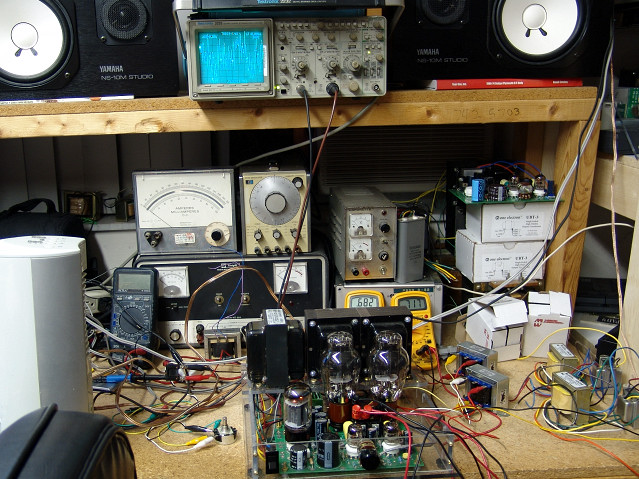
The Electra-Print transformers are on the rear right of the amp. The Edcors are connected up to the amp using clip leads. The Hammond 125CSE's are to the right of the Edcors, and the Triode units are on the far right of the bench. The amp was set up for listening tests, and measurements. The scope was used to find clipping and transformer saturation.
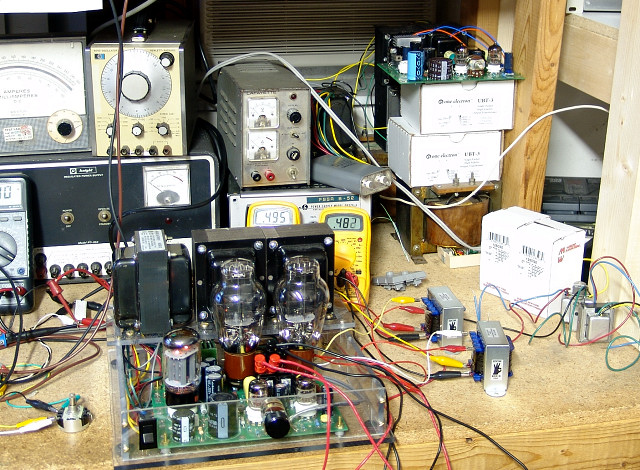
The other transformers were connected into the amp and compared to the Electra-Prints. This amp is running a small power transformer so that 45's, 2A3's and 300B's can be used. The B+ voltage is about 300 to 310 volts with 300B's, depending on the bias current. This (and the 5K load) limits the power to 5 or 6 watts.
Three different low cost transformers were tested. Both electrical and listening tests were performed. The bias was adjusted to the point where the third harmonic was minimized. This was 50 mA on the Electra-Print transformers. The 3 other transformers were tested at the minimum 3H point, and at 50 mA.
Electra-Print
These are the reference transformer, I have found nothing better for this amp. Best sound is achieved at 50 mA with 300B's. Distortion measures 2.3% at 4.5 watts (mostly 2nd harmonic), frequency response is 14Hz to 28.7KHz, and visible clipping appears just over 5 watts. Specs measured at 1watt: Frequency response 3.6Hz to 29.1KHz, distortion 0.91%. This transformer is only rated for 10 watts, but it is 5 times the size of the others. No visible saturation effects were seen at 5 watts and any frequency above 20Hz. The sound is excellent, this is the amp that I use daily.
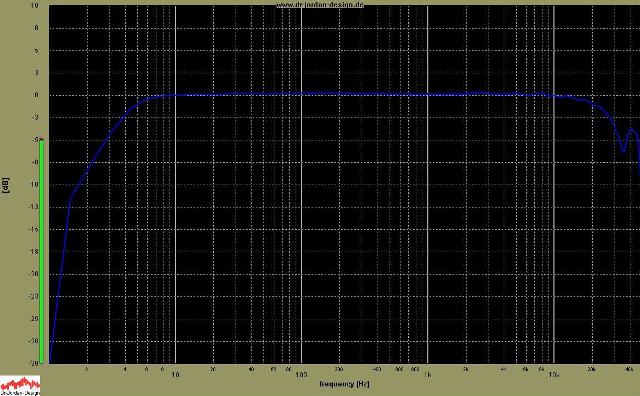 This is a frequency response plot of the amplifier operating at 1 watt with 300B tubes through the Electra-Print transformers. Response is ruler flat across the audio band, except for about 1 db of loss at 20 KHz.
This is a frequency response plot of the amplifier operating at 1 watt with 300B tubes through the Electra-Print transformers. Response is ruler flat across the audio band, except for about 1 db of loss at 20 KHz.
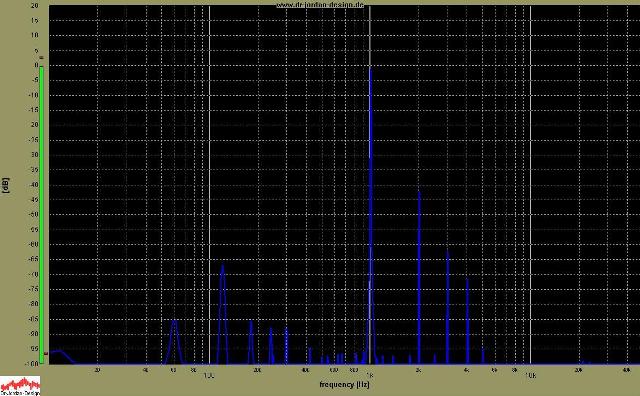 Distortion at 1 watt. Mostly second harmonic, but the third and fourth are clearly visible.
Distortion at 1 watt. Mostly second harmonic, but the third and fourth are clearly visible.
Hammond 125CSE
These have been the best choice in low cost transformers. Best sound is achieved at 70mA. This transformer makes about 1 watt more above 100Hz than the Electra-Print. Specs at 1 watt: frequency response is 11.7Hz to 42.9KHz with 50mA, and 10.4Hz to 44.2KHz with 70 mA. Distortion is .65% with 70mA (mostly 2nd harmonic). Distortion is 2.6% at 6.0 watts. Low frequency effects at 5 watts: Visible saturation can be seen on the scope for any frequency below 77 Hz at 50 mA, 64Hz at 80mA. clipping was observed at any frequency below 130Hz with 80mA, but none was noted at 50 mA. Low frequency distortion tests at 1 watt: 100Hz lowest distortion was 1.01% with 63 Ma. At 36 HZ .66% occurs with 58mA.
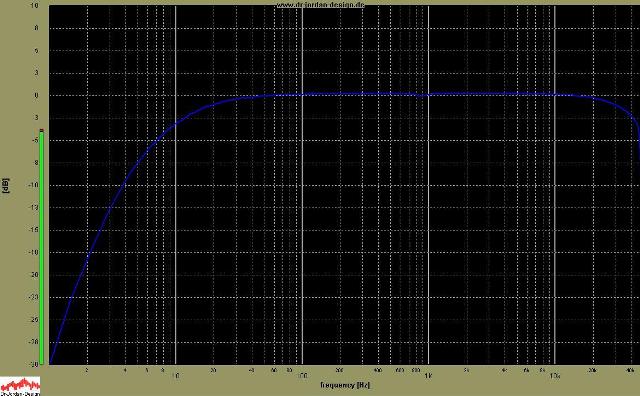 This is a frequency response plot of the amplifier operating at 1 watt with 300B tubes through the Hammond 125CSE transformers.
This is a frequency response plot of the amplifier operating at 1 watt with 300B tubes through the Hammond 125CSE transformers.
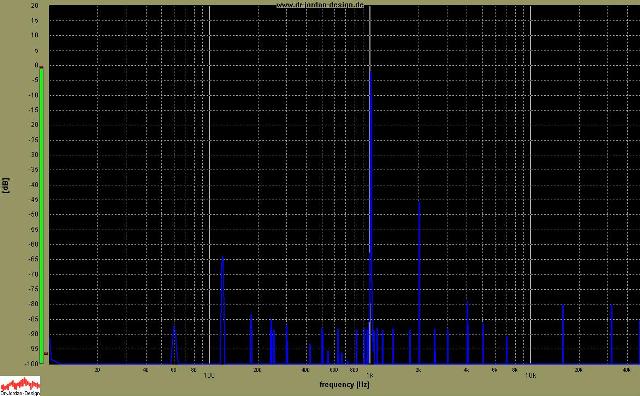 Distortion at 1 watt. Mostly second harmonic.
Distortion at 1 watt. Mostly second harmonic.
The two high frequency lines (15 and 30KHz) are because I forgot to turn the TV set off when I did the capture. The horizontal scanning frequency gets into the test system. The "small stuff" that 85 db down or greater only appears when external transformers are connected into the amplifier using clip leads. It is not known where it comes from, but at -85db I don't care. I believe that it is being picked up by all of the wiring, but even if it is real distortion, the best "golden ears" are not going to hear something going on that is 85 db below another sound present at the ear.
Edcor XSE15-8-5K
These are a new player in low cost transformers. Best sound is achieved at 80mA. This transformer makes about 2.5 watts more power than the Electra-Print from my amplifier. Specs at 1 watt: frequency response is 8.3Hz to 45.9KHz with 50mA, and 16.6Hz to 45.6KHz with 80 mA. Distortion is .75% with 80mA (mostly 2nd harmonic). Distortion is 2.6% at 7.2 watts. Low frequency effects at 5 watts: Visible saturation can be seen on the scope for any frequency below 74 Hz at 50 mA, 61Hz at 80mA. No clipping was observed at any frequency below130Hz with 80mA, and none was noted at 50 mA. Low frequency distortion tests at 1 watt: 100Hz lowest distortion was 1.41% with 57 Ma. At 36 HZ .61% occurs with 44mA
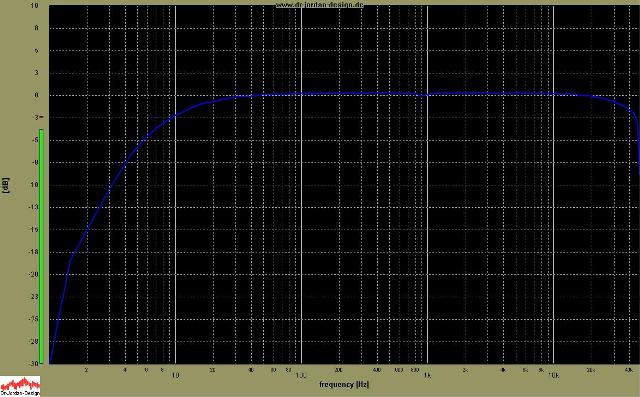 This is a frequency response plot of the amplifier operating at 1 watt with 300B tubes through the Edcor transformers. Response is ruler flat across most of the audio band. High frequency extension is flat to 30 KHz and the low frequencies are flat to below 50 Hz and 3 db down at 10 Hz. The bass response is slightly better than the Hammond transformers. HF is the best of ALL transformers tested.
This is a frequency response plot of the amplifier operating at 1 watt with 300B tubes through the Edcor transformers. Response is ruler flat across most of the audio band. High frequency extension is flat to 30 KHz and the low frequencies are flat to below 50 Hz and 3 db down at 10 Hz. The bass response is slightly better than the Hammond transformers. HF is the best of ALL transformers tested.
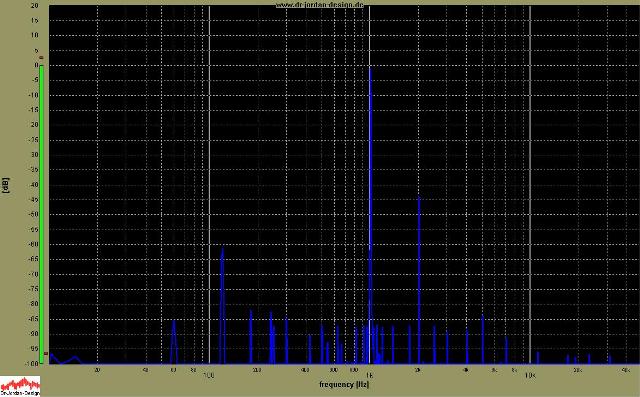 The distortion at 1 watt plot reveals only second harmonic and a little 120Hz hum. The "other stuff " is again more than 85db below the fundamental. Remember these are $18 transformers.
The distortion at 1 watt plot reveals only second harmonic and a little 120Hz hum. The "other stuff " is again more than 85db below the fundamental. Remember these are $18 transformers.
Triode Electronics TF103-48
This transformer is about half the size of the others tested. Specs at 1 W: frequency response 22.1HZ to 18KHz, at 50mA. and 18,9 HZ to 17.3KHz at 40mA. The distortion is .74% at 50Ma and .65% at 54 mA. Visible saturation occurs at 99Hz at 50Ma.
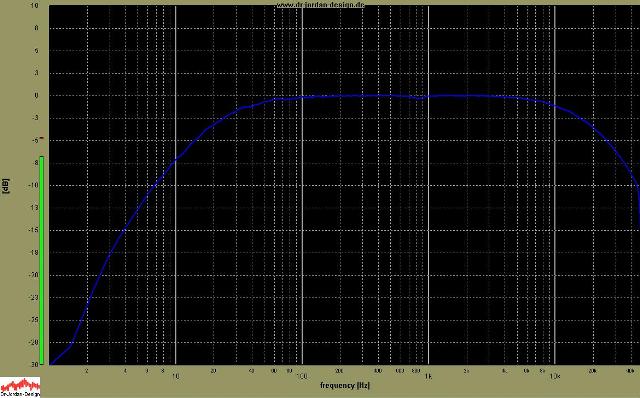 Response at 1 watt.
Response at 1 watt.
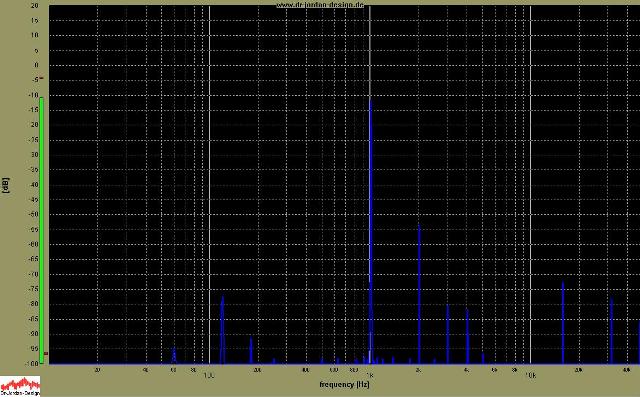 Distortion at 1 watt. This plot was accidentally taken with the reference level reduced by 10 db, everything is 10 db smaller than it should be, so most of the low level crud is just at the bottom edge of the screen.
Distortion at 1 watt. This plot was accidentally taken with the reference level reduced by 10 db, everything is 10 db smaller than it should be, so most of the low level crud is just at the bottom edge of the screen.
Conclusions
The Electra prints obviously are not afraid of any of these transformers, I listened to the Edcors, and the Hammond for a while and I find them very similar in specs. The Edcors like more current than the others. The little Triode unit was made to be used in a small guitar amp. It would work well there. It is just too small to be really useful in HiFi applications. If The Hammond and The Edcor were the same price, I would have to go with the Edcor. The fact that it is almost half price seals the deal. I would have no problem using them in a low cost amp. I have still used the Hammond in a guitar amp where the multiple impedance taps allow intentional mismatching to generate distortion. The Edcors are the only transformer tested that have UL taps.
The Sound tests showed what they usually do. The bigger the transformer, the better the sound. The Edcor and the Hammond are very similar sounding transformers.
The Edcor unit showed some anomalies in testing:
I adjusted the amps bias current for lowest distortion at several different frequencies. The Edcor transformer wanted less and less current as the frequency was decreased. This effect was not near as severe with the Hammond transformer. Both Edcor transformers exhibited this effect.
The Edcor transformer produced considerably more power than any of the other transformers tested. I got 7.5 watts at the onset of clipping with the Edcor, 6.1 watts with the Hammond, 6.0 watts with the Electra-Print, and 5.2 watts with the Triode unit. This indicates that it is a really efficient transformer, or that it is a lower impedance than 5K ohms (more likely). I will test this in the next few days.
More Testing
Another listening test was performed with myself and two of the testers that were present at the previous test. Only 2 transformers were tested, the Edcor, and the Hammond. As before the Electra-Print was used as the reference standard. The Triode unit was briefly auditioned, because one person asked to hear it. Most of the time was spent switching between the Edcor and the Hammond. All listening tests were done at 70mA of bias current (the Triode unit was tested at 50mA), which was the most that I wanted to run for a continuous (2 hours) test, since I was pulling 180mA (2 X 70 + 40) from a 120mA power transformer. I did not notice any saturation type distortion when listening to a bass guitar solo at full volume. The clipping that occasionally occurred did not sound very obvious (observed on scope).
Despite the low frequency anomalies I liked the bass better with the Edcor transformer. I believe that the Edcor unit sounded better, but there was a 1/2 hour setup time in between tests that makes it hard to tell. In fact the Edcor and the Hammond sounded very similar. Both sounded far superior to the Triode unit which was never meant to be used for HiFi. Neither sounded as good as the Electra-Print which costs (and weighs) 5 times as much although the differences were subtle.
I put some 45's into the Tubelab SE (don't do this unless the amp is made for it) and set the bias to 30 mA at 310 volts (yeah I know that I am over the line). I swapped between the Hammonds and the Edcors about 5 times. I played a lot of different music. On some music the two transformers sound very similar, on other music the difference is obvious, always in favor of the Edcors. The obvious differences are often unexplainable, but real. Female vocals sound more alive, pianos have more "sparkle", a whack of the tom-tom sounds more realistic, same with snares. I captured a decaying bass drum hit with the storage scope, perfect sine wave with evenly distributed decaying amplitude, this was with a speaker load and zero feedback.
A discussion had been ongoing on the diyAudio forums about these transformers, and questions were raised concerning the few impedance selections that were available. It was suggested that you could put an 8 ohm load on a 16 ohm (5K primary) transformer to get a 2.5 K load to the output tube. I volunteered to put a 4 ohm load on my amplifier and re run the tests. This would present a 2.5 K load to the 300B.
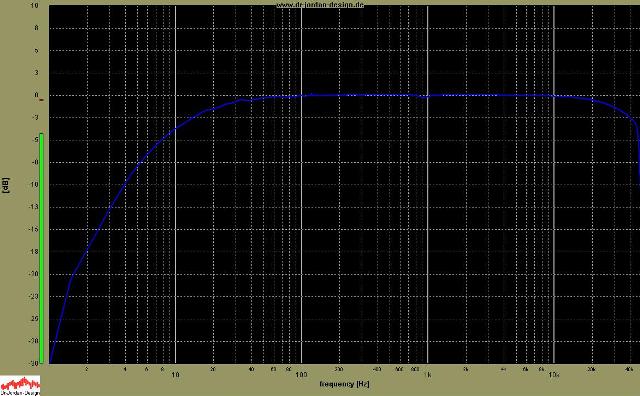 The amp lost a little low frequency response. The distortion plots looked similar to the 8 ohm plots. Maximum power output went up about 1 watt.
The amp lost a little low frequency response. The distortion plots looked similar to the 8 ohm plots. Maximum power output went up about 1 watt.
Even More Testing
I had become involved in testing the 6AV5 sweep tube due to another thread on the diyAudio forums.
- Anyone know anything about a 6AV5GA (see the 6AV5 Testing page)
This thread was running at the same time as the Cheap SE output transformers thread which lead to another thread The Edcor meets the 6AV5 which explored the combination of cheap transformers and cheap $3 output tubes. I had previously discovered that the Hammond transformers responded extremely well when cathode feedback was applied. I tested this on the Edcor transformers with extremely good results.
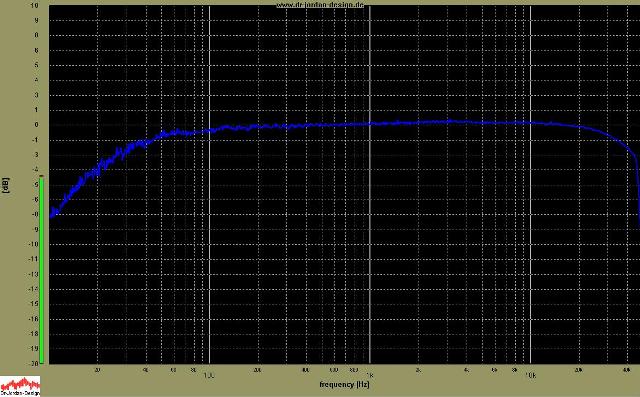 This is a frequency response plot of the 6AV5 amp running at FULL POWER which was 8 watts RMS. The scale is expanded at 1 db per division (the plots above are 3 db per division at 1 watt output). This means that the 1 db response is 40Hz to 35 KHz at 8 WATTS! The 3 db response is 19Hz to 45Khz at full power! This is super amp territory. This amp is running on 75 dollars worth of iron and 10 dollars worth of tubes! The distortion numbers were equally fantastic, but I can't find the plot. Same with the 1 watt response plots, they were lost when my hard drive died last year.
This is a frequency response plot of the 6AV5 amp running at FULL POWER which was 8 watts RMS. The scale is expanded at 1 db per division (the plots above are 3 db per division at 1 watt output). This means that the 1 db response is 40Hz to 35 KHz at 8 WATTS! The 3 db response is 19Hz to 45Khz at full power! This is super amp territory. This amp is running on 75 dollars worth of iron and 10 dollars worth of tubes! The distortion numbers were equally fantastic, but I can't find the plot. Same with the 1 watt response plots, they were lost when my hard drive died last year.
I listened to this breadboarded mess for almost a month. I finally took it apart so I could have my bench space back. I began work on designing an amplifier based on this work. I would consider this a great transformer for under $20. This one has convinced me to try some of their other transformers. It would be cool if they made a 200 watt SE transformer so I could finish my 833A amp.
Note: Since this page was written, I designed the Tubelab SSE, a triode or UL amp using popular low cost audio tubes, and the Edcor transformers. I have been listening to it daily for three weeks now, and I still can't believe that the TOTAL IRON COST for this amp is under $80! I set this amp up to use switchable cathode feedback. I prefer the sound and the power of UL mode with the cathode feedback turned ON.
Yes, Some More Testing
I created a test amp using the Tubelab SSE amp board. It was set up for experimentation, and output transformers could be swapped in minutes, using only a screwdriver.
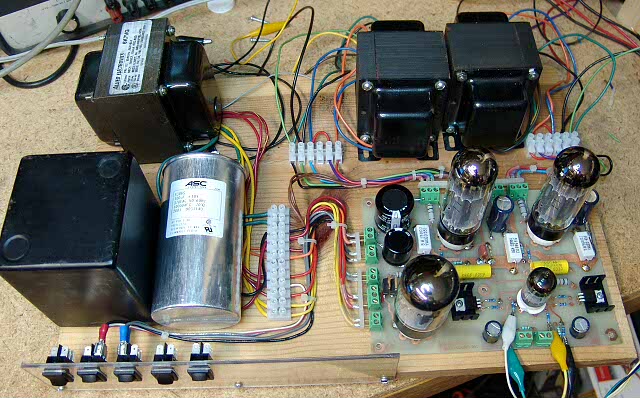
I ran some tests on the Transcendar and One Electron UBT-3 mentioned above. It was determined during listening tests that these transformers sound very similar. There are some differences in the two transformers in testing at the frequency extremes. If you compare the plots over the frequency range used my most music, they are very similar.
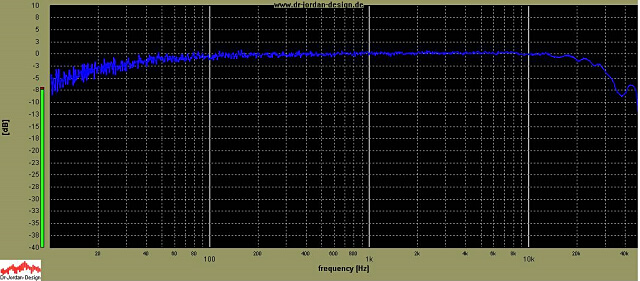 Above is a frequency response test on the Transcendar transformer. The 3db points are 19.4 Hz and 29.0 KHz. The amp (EL-34 triode) makes 5.3 watts continuous power at 5% distortion at 1KHz. Full power at 5% is available down to 48Hz. The maximum 5% power at 30 Hz is 3.92 watts. The maximum 5% power available at 20 KHz is 3.0 watts. This is fine for most music.
Above is a frequency response test on the Transcendar transformer. The 3db points are 19.4 Hz and 29.0 KHz. The amp (EL-34 triode) makes 5.3 watts continuous power at 5% distortion at 1KHz. Full power at 5% is available down to 48Hz. The maximum 5% power at 30 Hz is 3.92 watts. The maximum 5% power available at 20 KHz is 3.0 watts. This is fine for most music.
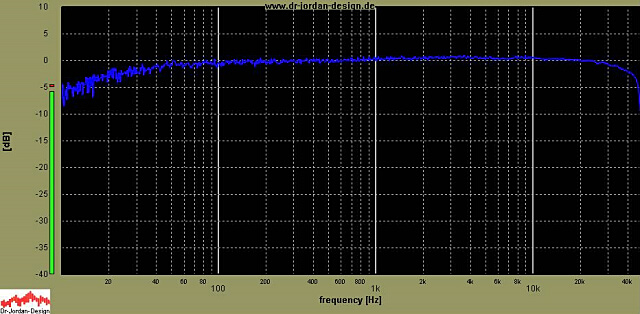 Above is a frequency response test on the One Electron UBT-3 transformer. The 3db points are 19.0 Hz and 44.1 KHz. The amp makes 5.12 watts continuous power at 5% distortion at 1KHz. Full power at 5% is available down to 42Hz. The maximum 5% power at 30 Hz is 3.0 watts. Full power is available to beyond 20 KHz
Above is a frequency response test on the One Electron UBT-3 transformer. The 3db points are 19.0 Hz and 44.1 KHz. The amp makes 5.12 watts continuous power at 5% distortion at 1KHz. Full power at 5% is available down to 42Hz. The maximum 5% power at 30 Hz is 3.0 watts. Full power is available to beyond 20 KHz
I have started another transformer testing page to find the right transformer to use in the SSE amp for several different budgets. I have performed power VS distortion sweeps at various frequencies. I have found that this correlates well with listening tests. This testing is outlined on its own page that is associated with the SSE amp.